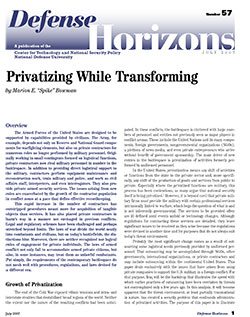DOWNLOAD PDF
 Overview
Overview
The Armed Forces of the United States are designed to be
supported by capabilities provided by civilians. The Army, for
example, depends not only on Reserve and National Guard components
for warfighting elements, but also on private contractors for
numerous roles no longer performed by military personnel. Originally
working in small contingents focused on logistical functions,
private contractors now rival military personnel in number in the
battlespace. In addition to providing direct logistical support to
the military, contractors perform equipment maintenance and
reconstruction work, train military and police, and work as civil
affairs staff, interpreters, and even interrogators. They also provide
private armed security services. The issues arising from new
roles are exacerbated by the growth of the contractor population
in conflict zones at a pace that defies effective recordkeeping.
This rapid increase in the number of contractors has
outstripped procedures meant more for acquisition of tangible
objects than services. It has also placed private contractors in
harm’s way in a manner not envisaged in previous conflicts.
Legal and regulatory schemes have been challenged and perhaps
stretched beyond limits. The laws of war divide the world neatly
into combatants and civilians, but on today’s battlefields, the distinctions
blur. Moreover, there are neither recognized nor logical
rules of engagement for private individuals. The laws of armed
conflict not only fail to accommodate armed private citizens, but
also, in some instances, may treat them as unlawful combatants.
Put simply, the requirements of the contemporary battlespace do
not mesh well with procedures, regulations, and laws devised for
a different era.
READ MORE >>